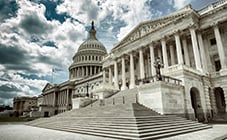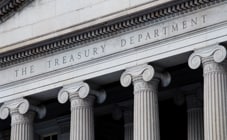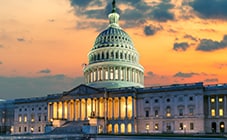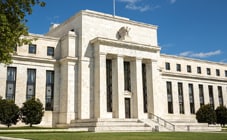>> Intro:
Welcome to the Wells Fargo, Ask Our Economists podcast series, where we explore what's on our clients’ minds, provide timely commentary on what's happening in the markets and discuss our outlook for the ever-changing investment landscape. Our economists provide their views on the latest domestic and global trends, insights on the demographics, social issues and challenges that impact our world, all which help you manage risk and capture opportunities. Join us as we take you down the road of navigating today's economic climate with confidence.
>>Jay Bryson:
Hello, I'm Jay Bryson, Chief Economist for the Corporate and Investment Bank at Wells Fargo. And you're listening to the Ask Our Economists podcast series. You know, the fiscal deficit of the U.S. government and the debt of the U.S. government has been in the news a lot lately, due in part to some of the debates that, you know, has occurred in Congress over the last few months. And, you know, let's face it, we're entering an election year. These debates really aren't going to go away any time soon. And we've gotten a lot of questions about the deficit and the debt. And so we thought we'd do a podcast today. And I can't really think of any better person to join me today than a senior economist, Mike Pugliese, who is our our real expert when it comes to fiscal policy matters.
>>Mike Pugliese:
So, Mike, let's start just kind of level set for us. You know, where is the deficit of the U.S. federal government today? Where's the debt? And what's kind of happened to that in the last few years? Thanks, Jay. So I think the easiest place to start is where were we before the pandemic and try to compare and contrast that today. So pre-pandemic, the federal government was running a budget deficit of about 4.5% of GDP. And to give some additional context on that, the long run average. So the average over the previous half century is about 3.5%. So the deficit was a little bigger than it had been historically, but, you know, not enormous by any means. And the national debt was about 80% of of GDP. And then the pandemic struck and a couple of things happened. First, we had a very weak economy in 2020 due to the devastation that was wrought by COVID 19. And then you also had a significant amount of federal aid that was enacted in response to the pandemic, trillions of dollars of different kinds of spending to keep the economy afloat. And so the deficit widened very substantially and the national debt went from, again, about 80% of GDP in 2019, all the way up to 100% or so over the course of just that one year period initially when the pandemic struck.
>>Jay Bryson:
Okay. Thanks for that, Mike. And I think it's interesting, you know, you kept talking about as a percent of GDP and, you know, you do hear a lot of headlines about the debt today is at its highest level ever. Well, anything that kind of grows over time, that's what's going to happen. Just like the US economy today is the biggest it's ever been. So, you know, I think it's important to, you know, to keep those things into perspective. Always have to measure as a percent of something in GDP is the way we we typically measure those sorts of things. So what about the situation today? You know, you talked about the devastation by pandemic on the economy. You know, clearly we're back to full employment now. Unemployment rate below 4% of GDP at an all time high here in the United States. What about the deficit today? Is that is that receded, as is the debt going down? What's what's what's going on there?
>>Mike Pugliese:
Yeah. So as the economy has recovered, you seen a debt situation that has at least so far stopped getting worse. So like I said, the national debt as a share of the economy peaked at about 100% of GDP. And that's about where it is today. It’s at about 95%. So it's come down a little bit, but it's still well above where it was pre-pandemic. And in terms of the deficit, which again, the deficit’s the borrowing you do over a period of time, in this case, the annual budget deficit’s, normally what we're talking about you know over a one year period, that's a little bit wider than it was before the pandemic. So again, it was about 4.5% percent of GDP in 2019. Today, I would say it's between about 6% or 7% of GDP. And the natural question you might ask is, well, what's driving that? Right? Well, on the revenue side, you’ve seen tax receipts that are basically just normalized as a share of the economy compared to where they were pre-pandemic. So about 17% or so of GDP is what the federal government collects in tax revenue. And that's about what it was before the pandemic. And it's whipsawed around quite a bit. It weakened in 2020 when the economy was in bad shape. Then actually strengthened quite a bit in 2022. And the economy was booming and tax receipts on capital gains were up a lot because home prices and stocks and everything else had gone up so much. But, you know, today tax receipts as a share of the economy are basically just back to normal. But on the spending side, it's a little bit higher. So, you know, spending which skyrocketed again in 2020 and 2021, it's it's fallen directionally, but it's still a little bit higher than it was in 2019, not just in dollar terms, but even as a share of the economy. Okay. So that's interesting. It sounds like we've normalized in terms of the revenue side, but we certainly haven't normalized in terms of the spending side. What's driving the spending higher, you know, in the last couple of years. Yes, I would say it’s a few things Jay that's driving that. So first, it's there's some just structural budget pressures that were ongoing before the pandemic and have continued over the past several years. So the aging of the population and the upward pressure that puts on entitlement programs, spending for things like Social Security and Medicare, which is, you know, the health insurance program for the elderly, some of its new policy initiatives. So whether that is the infrastructure bill that was passed a couple of years ago or more spending on veterans, which was an initiative that's occurred under the Biden administration or more defense spending, as we've seen, you know, supplemental spending bills to support Ukraine and other national defense priorities. So some of it's been new policy initiatives. And I think the biggest driver has probably been higher interest costs on the national debt as we went from a very low period of interest rates both before and right after the pandemic to rates that have gone up substantially. What is really not at this point is COVID aid and pandemic aid. I mean, there's still a little bit of lingering stuff there, particularly with some tax credits and stuff like that. But, you know, at this point, the unemployment benefits that were expanded have run their course. The direct checks have gone out. The paycheck protection program is over. And so it's really not COVID aid. It's these other factors like higher rates, an aging population and some new policy initiatives related to infrastructure and defense and other things.
>>Mike Pugliese:
Okay. So you just mentioned interest rates. Obviously, interest rates are very high today, at least relative to the last two decades or so. I don't think anyone's expecting them to go back down any time soon. So what sort of effect will that higher interest rates have on on the deficit and then on the debt? Yeah.
>>Jay Bryson:
So the interest spending is an interesting one, Jay, because pre-pandemic the US federal government was only spending about about 1.5% of GDP on interest costs, and that's actually quite low despite the fact that the national debt was on the higher side compared to historical averages in the 2010s, interest spending was still pretty low compared to the 1980s or the 1990s and some of the preceding decades because interest rates are so low.
>>Mike Pugliese:
You had an economy that was growing about 2% in real terms then at about 2% inflation. So 4% nominal GDP growth. You know, interest rates that were were 2% or even less. And today we're in a much different situation. Interest rates are 4% to 5%, even a little bit above 5% at the very front end of the yield curve. And that's put upward spending on those interest costs. So today, net interest spending by the federal government’s about 2.5% GDP. So it's gone up a full percentage point and still rising. It's continued to trend higher over the course of this year.
>>Jay Bryson:
Okay. So 64, we'll call a $64 trillion question. I mean, do you think that's a major risk to the US economy, at least in the, you know, in the foreseeable future here?
>>Mike Pugliese:
Well, I think in the near term, no. And I think that for a few reasons. So first, I think it's important to remember that, believe it or not, we've been at these debt levels before. Now, you made the point earlier, Jay, you know, all variables in the economy go up over time in dollar terms. This is the biggest economy we've ever had, the biggest debt we've ever had, the biggest a lot of things. But as a share of GDP, the national debt is about 100%. And we've seen those those debt burdens once before, during and then the immediate aftermath of World War Two. So, well, that's high. It's not unprecedented. Similarly, interest spending as a share of the economy at 2.5% or so is up compared to the 2010s and the 2000s. But it's actually below still where it was in the 1980s and the 1990s when rates were significantly higher. So at that time, interest spending as a share of the economy was bouncing around 3% or so. So we're still a little bit below that. And then finally, I think it's important to remember that not all debt is refinanced at once in short term debt and things like Treasury bills, you know, that mature every 90 days or 180 days or so two-year notes. You know, some of that low interest rate debt has probably already been refinanced at higher rates. But but not all of it has. So the the weighted average maturity of the Treasury market, it's about six years, so it takes some time for those higher rates to be fully felt. And we are seeing that. But it's it's not a process that happens instantaneously. So, you know, I don't think that there's any reason to panic here. But I do think there are some causes for concern. I mean, if you compare today to that post-World War Two period, the demographics are a lot more challenging on a, you know, ten or 20 or 30 year horizon. And I also think the long term interest rate outlook is uncertain. There's a lot of debate right now about, you know, will interest rates go back to pre-pandemic levels or will they stay high or maybe even go higher from here? And not just that, but, you know, it depends on if long term rates are higher, if they are indeed higher over the next decade for, you know, good or bad reasons. And I'm kind of using air quotes there. But higher long term rates can be driven by a lot of different factors. Some of them good, some of the bad.
>>Jay Bryson:
Okay. So can you define that? I mean, what the heck do you mean by good reasons? And what are some of the bad reasons?
>>Mike Pugliese:
Yeah. So when I say, you know, good reasons, rates might be higher. So when I think about why interest rates were higher in say, the 1990s or the 2000s than they were in the 2010s, there are a lot of reasons and one reason that rates were higher back then is because the economy grew faster. You know, in economic lingo, the potential growth rate of the economy was higher in, say, the 1990s than it was in the 2010s as we had a more favorable demographics, faster labor force growth, faster productivity growth. And that in turn gave you higher interest rates and I don't necessarily think that would be a bad thing if over the next decade the economy is going to grow a little faster than it did in the 2010s. That should mean all else equal higher rates. But I don't necessarily view that in and of itself as a problem for the national debt. I think we would welcome higher rates alongside faster economic growth. But, you know, if the higher rates are say, you know, predominantly for for bad reasons because much bigger deficits or there's a lot more uncertainty in the world than investors might demand an additional premium for locking up their money for an extended period of time, you know, five, ten, 30 years. It's kind of to once again use some econ lingo, it's term premium for those investors. And so I think it's not just about why are rates higher, but also what's driving it. If it's the faster economic growth, I think that'd be a good thing. If it's uncertainty and more debt, more deficits, I think that would be a concerning reason for higher rates and by extension a concern for the fiscal outlook and the economic outlook. So maybe kind of sticking to that, you know, tail risk downside theme, Jay, you know what are some of the downsides of a a high and rising public debt? Okay.
>>Jay Bryson:
Well, I can think of a few just call it downsides or negatives in terms of a large public debt would be one would be and I think this is one of the minor ones. About a third of Treasury debt is held by foreigners. And so we'd have to pay interest on that. That represents an outflow of resources from the economy to foreigners. You know, some of these could be geopolitical adversaries and maybe that's not a good thing. But but I think probably more important is a larger debts can be you were talking about bad interest rate outcomes. You know, one of those things if we if the Treasury does have to pay higher interest rates to borrow, that then feeds into higher corporate bond spreads everything else equal. Corporate bonds are usually priced off a spread on U.S. Treasuries. So if the U.S. Treasury is paying more for its debt, probably means corporations have to invest and crowd out private investment. That's probably as good as a big downside. And the second thing is it just potentially can constrain policymakers in the future. You think about the you know, with the pandemic when it shut down the economy, we had you know, we had the CARES Act, which kind of got the economy across the valley of the of that first few months when the economy was kind of shut down. If we're constrained in our ability to do that, perhaps policymakers can't respond as quickly. You know, in the future to, you know, some sort of crisis that that comes about. So, you know, speaking about policymakers, I mean, what's what's the outlook here, Mike? Do you think we're going to take any corrective action anytime soon?
>>Mike Pugliese:
Yeah, I think as we get ready to turn the calendar to 2020 for meaningful policy change on the federal fiscal front’s pretty unlikely. You know, yes, Congress is still debating a budget for fiscal year 2024. That's why these government shutdown headlines keep coming into the news what feels like every other month. But I think it's important to bear in mind that those government shutdown headlines are really only about the annual discretionary parts of the budget. So, you know, every year Congress does the 12 appropriation bills that set discretionary spending for national defense and, you know, many other government activities. But that only comprises about 25% of total government spending. The remaining 75% is basically on autopilot. That's Social Security, Medicare, Medicaid and programs where, you know, if the spending level is determined by eligibility and it's not Congress sitting down and saying, okay, this year we're going to spend X amount of money on this program, and Y amount of money on this program, and the distance between the two parties is in the grand scheme of things, I don't think going to make a big dent in the $2 trillion or so annual budget deficit. And so unless we were to see changes on the entitlement spending front, which I really don't think is likely in an election year and divided government, you probably won't see big changes on the spending side and the same on the tax side. You know, tax policy is pretty much set in stone for 2024 and I don't think you're going to see any changes there until we get to 2025 on the other side of the election and when the 2017 tax cuts enacted under former President Trump, a big parts of that bill are set to expire. And so, you know, if there is changes coming on the horizon, I don't think it's a 2024 phenomenon. I think it's probably 2025 or 2026 when we'll have a new Congress, a new president, and you'll have some kind of impetus for change. That impetus being, you know, big expirations of the 2020 - 2017 tax bill. So pull it all together for us Jay. You know we've covered a lot of ground here just to kind of summarize it, that the deficit's wider today than it was pre-pandemic. It's gone from, call it 4.5% of GDP to 6% to 7% of GDP. Doesn't seem like there's going to be any fiscal consolidation and in the near future. O bviously, interest rates are a big swing factor, but there's a lot of uncertainty there really in both directions. How do you think about those factors when you think about the outlook for the national debt and also just the economic outlook more broadly in the years to come?
>>Jay Bryson:
That's a good question, Mike. And, you know, I think I share your opinion that, you know, I don't lay awake at night worrying about where we are today. And I don't think the market is overly concerned either. If the market was overly concerned about the fiscal outlook in the United States, I think the yield on the ten year Treasury security, which is kind of the benchmark rate, would be significantly higher than what it is up here today. You know, the U.S. has a lot of factors going on going on for it. It's the world's largest economy in terms of capital markets. It's the capital markets in the United States are the deepest, most liquid, most transparent financial markets in the world. The treasury market is of all the sit down still markets. The market for U.S. treasuries is clearly, you know, the predominant sort of sovereign debt market out there as well. And so I just don't see foreigners dumping U.S. debt any time soon. But, you know, we're also in the long term sense, we're on a on an unsustainable trajectory. And we do have to make a fiscal correction in our view, because we have a relatively low tax base in the United States, because we have a relatively low spending base in the United States, at least relative to many of our competitors, you know, our situation is manageable, but you got to have the political will to to make those corrections. And given what we've seen over the last two decades or so, in terms of some of the paralysis, political paralysis in the country, you know, again, I don't like you just pointed out, nothing's probably going to get done in the next year or two. It's something I'm beyond that. And the question is, do we have the political willingness to do that? You know, we have the the economic ability to make the adjustments. The question is the political one. And that's a that's just of clearly I had a question. I think anyone can really answer that at this point in time. So, again, I don't worry about the deficit today or the debt today, but it's something that we we do need to have a fiscal correction at some point over the next few few years. This listen, this you know, this debate is not going away anytime soon. There'll be a lot more questions coming up. And I will continue to as as we have our thoughts evolve on this. We'll continue to post new podcast, the new reports about the deficit and other social, other economic issues that may be on your mind. So please keep the questions coming, which we enjoy doing these podcasts for you to offer our insights. And thank you very much for for joining us today.
>>Outro:
That’s all for this episode of the Ask Our Economists podcast and we thank you for joining us. If you enjoyed today’s episode, please share with colleagues, family, friends, and anyone who listens to podcasts. If you have any economic related questions or topics you would like to hear about in an upcoming episode, please email us at askoureconomists@wellsfargo.com. Ask Our Economists is produced by Wells Fargo.
>>Disclosures:
This podcast should not be copied, distributed, published, or reproduced, in whole or in part.
The views expressed on this podcast represent the opinions of the authors on prospective trends in the domestic markets and the financial institutions industry and is intended for global financial institutions partners and customers, and other market participants who are customers of Wells Fargo. The views expressed within are not intended as a recommendation offer or solicitation with respect to the purchase or sale of any security or other financial product nor does it constitute professional advice. The views and opinions expressed are also not necessarily those of Wells Fargo and may differ from the views and opinions of other departments or divisions of Wells Fargo. Wells Fargo does not make any representation or warranty, express or implied, as to the accuracy or completeness of the statements or any information expressed within this podcast and any liability therefore (including in respect of direct, indirect, or consequential loss or damage) is expressly disclaimed.
We do not guarantee this information but have obtained it from sources we believe to be reliable. Opinions expressed are based on our experience and judgment as of this recording and are subject to change without notice. For the latest views of the Wells Fargo Economics team, please visit www.wellsfargo.com/cib/insights/economics.
This is not an offer to sell or to buy any security or foreign currency. Any past performance discussed during this podcast is no guarantee of future results. Any forward-looking statements or forecasts are based on assumptions and actual results may vary from any such statements or forecasts.
Any indices referenced are for performance comparison are unmanaged and cannot be invested into directly. As always please remember investing involves risk and possible loss of principal capital; please seek advice from your licensed professionals.
All price references and market forecasts are as of the date of recording.
Wells Fargo Corporate & Investment Banking (CIB) and Wells Fargo Securities (WFS) are the trade names used for the corporate banking, capital markets, and investment banking services of Wells Fargo & Company and its subsidiaries, including but not limited to Wells Fargo Securities, LLC, member of NYSE, FINRA, NFA, and SIPC, Wells Fargo Prime Services, LLC, member of FINRA, NFA and SIPC, and Wells Fargo Bank, N.A., member NFA and swap dealer registered with the CFTC and security-based swap dealer registered with the SEC, member FDIC. Wells Fargo Securities, LLC and Wells Fargo Prime Services, LLC, are distinct entities from affiliated banks and thrifts.

 Sign On
Sign On 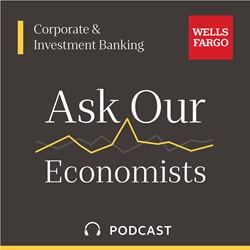 The “Ask Our Economists” podcast is a series where we explore what’s on our clients’ minds, provide timely commentary on what’s happening in the markets, and discuss our outlook for the ever-changing investment landscape. Our Economists provide their views on the latest domestic and global trends, insights on the demographics, social issues, and challenges that impact our world all which help you manage risk and capture opportunities. Join us as we take you down the road of navigating today’s economic climate with confidence.
The “Ask Our Economists” podcast is a series where we explore what’s on our clients’ minds, provide timely commentary on what’s happening in the markets, and discuss our outlook for the ever-changing investment landscape. Our Economists provide their views on the latest domestic and global trends, insights on the demographics, social issues, and challenges that impact our world all which help you manage risk and capture opportunities. Join us as we take you down the road of navigating today’s economic climate with confidence. 


